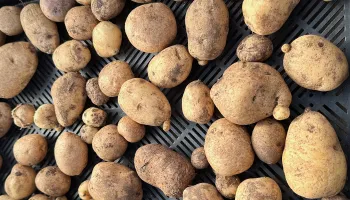Scientific Name
Solanum tuberosum
General Information

Potatoes are a cool season perennial grown as an annual. They are native to the Andes region of South America. Potatoes are fun and easy to grow and thrive when air temperatures are less than 65 degrees Fahrenheit. They are a member of the Solanaceae or nightshade family.
When to Plant
Depending on microclimate, plant potatoes between February and May and as late as August in cooler areas. Tuber production occurs underground until soil temperatures reach 80 degrees.
Planting
Plant only certified seed potatoes to avoid disease. Cut large tubers into chunks about one and a half inch in size with at least one eye. Three eyes or buds are even better. Spread the chunks on newspapers in a warm well-ventilated place to callus for a few days before planting. Small potatoes the size of an egg can be planted whole.
Dig an eight inch deep trench in well-drained, moderately fertile soil. Plant potato pieces, cut side down, in the bottom of the trench 10 to 12 inches apart. Cover with three to four inches of amended soil. When the plant is six inches tall, cover with another three inches of soil. This is called hilling and can be done again after six more inches of plant growth. Hilling increases production and prevents greening. Potatoes are easily grown in containers. Be sure to keep tubers covered with soil or mulch.
Soil Requirements
Prepare beds several weeks before planting. Dig in organic material such as compost and lightly amend with a fertilizer to create a loose, light, well-drained, moderately fertile soil. (Example: add aged manure or an organic soil amendment blend.) Potatoes prefer slightly acidic soil (pH 6.0 to 6.5).
Water Requirements
Depending on weather, water lightly once or twice a week, just enough to keep the soil from cracking and to avoid rot. Stop watering after the plants bloom, begin to turn yellow, and begin to die back.
Fertilizing
If nutrient balance is inadequate, use fertilizer with more phosphorus and potassium than nitrogen. Excess nitrogen promotes leaf growth at the expense of potatoes. Ideally, test soil nutrients prior to planting and amend as needed then.
Pollination
Self-pollinating
Harvesting
Potatoes mature in 90 to 120 days. Harvest can be spread out over several weeks.
“New” (young) potatoes can be harvested soon after the plant starts flowering, but be careful when you peek into the soil to not damage the plants.
When 20% to 100% of leaves have yellowed, harvest potatoes by digging well away from the plant stem. Use your hands as digging tools may damage tubers. Discard green potatoes, which contain a high level of toxic alkaloid solanine. Alternatively, cut plants at ground level and leave the crop in the ground for another couple weeks, without watering, to harden-off the skin.
Discard the leaves and all tiny green fruit that can spread disease.
Storage
Store potatoes in a cool, dark, well-ventilated place. Exclude light to prevent greening. Use within six weeks for best flavor and texture.
Good Varieties for Marin
- ‘Buffalo’
- ‘Bison’
- ‘Carola’
- ‘Carlotta’
- ‘White Rose’
- ‘Kennebec’
- ‘Chieftain’
- ‘Nargold’
- ‘Russet’
- ‘Red Lasoda’
- ‘Red Pontiac'
- ‘Yukon Gold’
- ‘Russian Banana’
Helpful Tips
Plant only certified seed potatoes. Practice crop rotation. Avoid heavy, wet soil. Keep potato tubers covered with soil or mulch while growing.
Common Problems
Scab, a fungus, may cause blemishes on the surface. Simply peel off.
Early and late blight, two fungus diseases, cause plants to collapse and make potatoes inedible. Use certified seed potatoes and avoid overhead watering.

